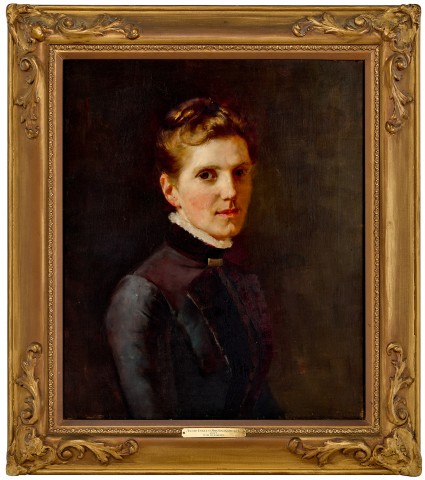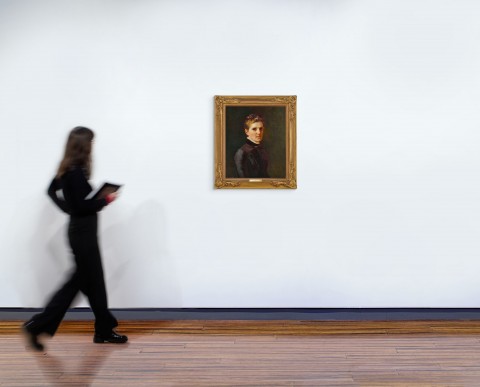Portrait of Annie Springthorpe [née Inglis], 1887
Tom Roberts
oil on canvas
60.5 x 51.0 cm
Dr John Springthorpe, Melbourne, commissioned directly from the artist, 1887
Private collection
Sotheby's, Sydney, 16 August 1999, lot 67
Private collection, Melbourne
Barbour, F. H., 'Jottings', 1887 - 88, La Trobe Collection, State Library of Victoria, Melbourne, MS 8746
Cotter, J., Tom Roberts and the Art of Portraiture, Thames & Hudson, Melbourne, 2015, fig. 5.15, p. 214 (illus.)
Annie Springthorpe and Enid Springthorpe, 1891, oil on wood panel, 37.5 x 27.5 cm (irreg.), private collection
ACCOMPANIED BY FAMILY HISTORY BOOK In Memoriam by Dr John Springthorpe, c.1897, following the death of his wife Annie (née Inglis).
An important member of the Australian Impressionists, Tom Roberts is hailed as the father of Australian landscape painting. He is particularly renowned for the creation of nationalistic pictures such as Shearing the rams, 1888 – 90 (National Gallery of Victoria) and A break away!, 1891 (Art Gallery of South Australia), which were painted in the years leading up to Federation and celebrate nineteenth century rural life and masculine activity.
Roberts was also a skilled painter of people, able to capture the mood and character of his subjects, as well as their physical likeness, and in fact portraiture makes up around a third of his painted oeuvre. As Mary Eagle observed, ‘he was a different painter when tackling portraits. Almost invariably they evoked from him sure, subtle and sophisticated brushwork and an equally competent characterisation.’1 His motivation was sometimes practical – as he once explained to a friend, ‘Portraits pay… my boy’2 – with commissions of politicians and other public figures easier to secure than patronage for large and time-consuming subject and history pictures.3
Soon after his marriage to Annie Inglis in January 1887, Dr John Springthorpe commissioned this portrait of his new wife who he described as ‘self-sacrificing, modest, tender, true and wise.’4 Springthorpe was a distinguished Melbourne doctor – a graduate of the University of Melbourne who in 1881 became the first Australian to gain membership to the Royal College of Physicians – and a keen patron of the visual arts. He had commissioned Roberts to paint his own portrait in 1886 and later, John Longstaff also painted him on two occasions. Springthorpe purchased works by Roberts, Streeton and Conder from the famous 9 x 5 Impression Exhibition of 1889 and when his art collection was sold following his death, The Argus reported that, among others, it also included work by Hans Heysen, Louis Buvelot, H. J. Johnstone, J. H. Scheltema and Web Gilbert.5
Seated close to the picture plane and looking out towards the viewer, Annie Springthorpe exudes a serene confidence which belies her youth. She was only twenty years old at the time and as her friend, Fanny Barbour, observed, ‘I’m sure if she wasn’t married she’d just be a madcap school-girl.’6 Roberts describes her features and delicate complexion: rosy cheeks, brown eyes and auburn hair – golden when it catches the light – which is drawn up onto her head. Characteristically, he also takes pleasure in the depiction of her clothing, from the lace collar and gold brooch at her neck to the stylised ruffled panel down the front of the dress which is masterfully described entirely in black paint. Although black clothing often signified mourning, Julie Cotter explains that it held other meanings at this time – ‘power, elegance, urbanity, subversion and sexual allure’ – and that Roberts incorporated these into his images of women.7
Roberts painted Annie Springthorpe again in 1891, this time an intimate and informal portrait with her young daughter Enid on a small wood panel. Six years later she died prematurely during the birth of her fourth child. Bereft at the loss, John Springthorpe memorialised his beloved wife in a book (a copy of which accompanies this painting) and an extravagant temple-like monument at the Boroondara Cemetery, Kew. A collaboration between architect Harold Desbrowe Annear, sculptor Bertram Mackennal, the artist John Longstaff and others, it was completed in 1901 and is now on the Victorian Heritage Register.8
1. Eagle, M., The Oil Paintings of Tom Roberts in The National Gallery of Australia, National Gallery of Australia, Canberra, 1997, p. 54
2. Tom Roberts, cited in Taylor, G., Those Were the Days, Sydney, 1918, p. 100, cited in Topliss, H., Tom Roberts 1856 – 1931, A Catalogue Raisonné, vol. 1, Oxford University Press, Melbourne, 1985, p. 20
3. See Topliss, ibid.
4. Jalland, P., ‘Magnificent obsession’, The Age, Melbourne, 23 March 2002, at: https://www.theage.com.au/entertainment/books/magnificent-obsession-2002... (accessed 1 September 2025)
5. ‘Dr. Springthorpe’s Art Collection Sold’, The Argus, Melbourne, 25 May 1934, p. 5
6. Barbour, F. H., Jottings, 1887 – 88, La Trobe Collection, State Library Victoria MS8746
7. Cotter, J., Tom Roberts & the Art of Portraiture, Thames & Hudson, Melbourne, 2015, p. 214
8. Sanders, A., ‘Springthorpe, John William (1855 – 1933)’, Obituaries Australia, National Centre of Biography, Australian National University, at: https://oa.anu.edu.au/obituary/springthorpe-john-william-8610/text24842 (accessed 1 September 2025). See also Sanders, A., ‘Less than Six Degrees of Separation’, lecture given at the National Portrait Gallery, 28 May 2011, at: https://www.portrait.gov.au/content/less-than-six-degrees-of-separation (accessed 1 September 2025)
KIRSTY GRANT


